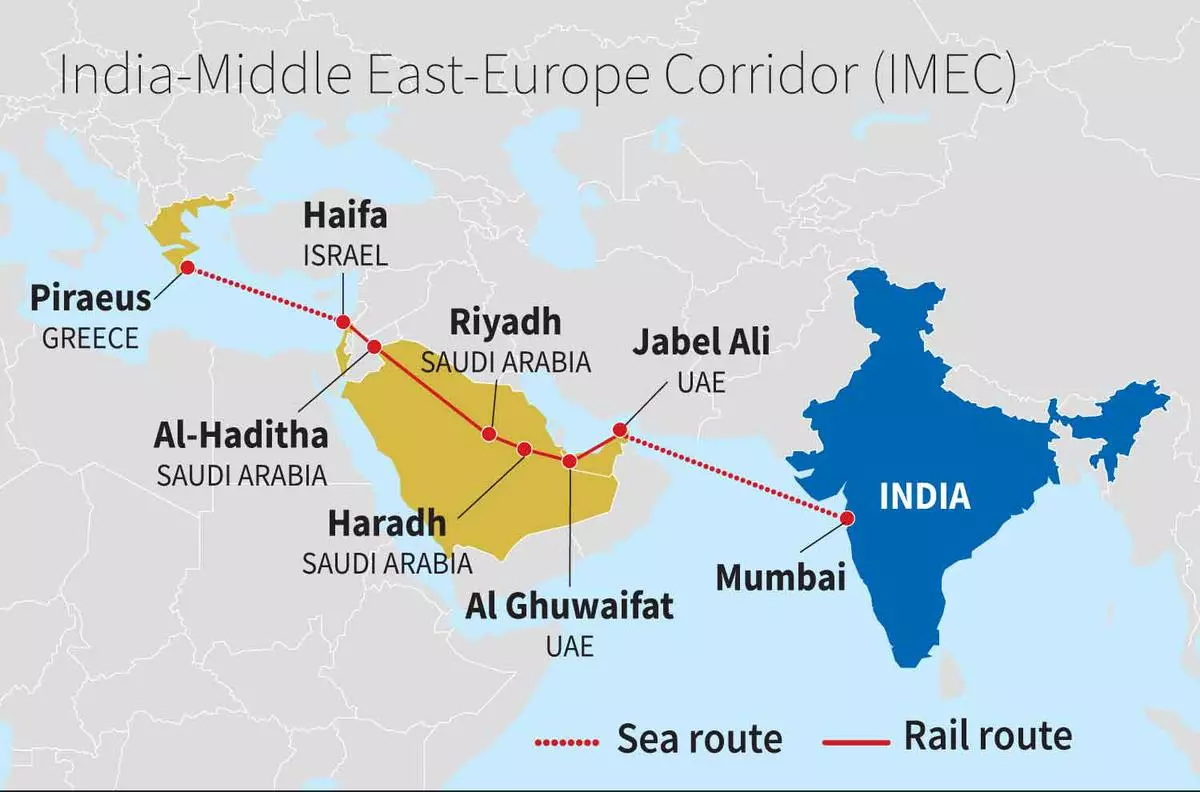India- Middle East Economic Corridor (IMEC)
Context:
- As the Red Sea crisis enters its fourth month, global supply chains are increasingly grappling with inflated freights, delayed vessel schedules, and product shortages. It has once again brought to the fore the vulnerabilities of global supply chains, highlighting the need to revisit alternate routes for global trade.
- At this juncture, the study about the relevance of IMEC becomes necessary.
What is IMEC?

- On the sidelines of the G20 Leaders’ Summit(Sept. 2023), Leaders of India, European Union, France, Germany, Italy, Saudi Arabia, UAE and US announced an MOU committing to work together to develop a new India-Middle East-Europe Economic Corridor (IMEC).
- The IMEC will comprise two separate corridors,
- the east corridor connecting India to the Gulf and
- the northern corridor connecting the Gulf to Europe.
- The corridor will provide reliable and cost-effective cross-border ship to rail transit networks to supplement existing maritime routes.
- It intends to increase efficiency, reduce costs, secure regional supply chains, increase trade accessibility, enhance economic cooperation, generate jobs and lower greenhouse gas emission, resulting in a transformative integration of Asia, Europe and the Middle East (West Asia).
Current status of IMEC- Challenges:
- Lack of Committed investments: Apart from the MoUs, there have not been any investments or operations regarding the corridor.
- Multi nation transit: Multiple Countries are involved which can make the cross border movement of cargo slow and tedious.
- Israel-Palestine conflict has put a pause on the normalisation of Arab-Israel relations which is a key element of the multi-nation initiative.
- Vulnerability of the Strait of Hormuz: The entire trade of the IMEC architecture flows through the Strait of Hormuz and with Iran’s proximity and control over the strait, the risk of disruptions remain very high.
How can the IMEC be made viable?
- Quantification of economic costs and benefits: An empirical study on the economic benefits of the corridor needs to be conducted.
- The corridor is estimated to cut the journey time from India to Europe by 40% and slash transit costs by 30%.
- However, there are speculations that multiple handling of cargo and multi-nation transit would increase carriage and compliance costs.
- Therefore, it is critical to quantify the economic advantages of the corridor to attract more stakeholders.
- Inclusion of Oman: The Strait of Hormuz problem can be avoided by including Oman in the IMEC architecture and keeping the supply chain away from Iran’s reach.
- Financial Support systems: A robust financial framework needs to be in place. Since there are no binding financial commitments on any of the signatories of the corridor, investments will have to be attracted from governments, international organisations, and private sector entities.
- A comprehensive multi-nation operational framework is needed. As the corridor involves facilitating trade across different legal systems, a multi-national framework is necessary.
- A forum for the corridor needs to be constituted to undertake the aforementioned activities.
As global supply chains are battling delayed shipments and rising costs, China is actively projecting China-Europe freight trains, which are part of the Belt and Road Initiative (BRI), as an alternate route. This situation makes IMEC more relevant to India than any other country.
Subscribe
Login
0 Comments
